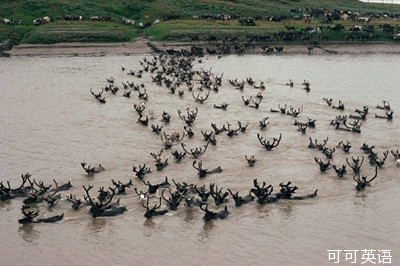There must have been astonishing places ... you can imagine the mammoths, and the herds of horses and deer. And the birds, the migrating birds, I think, had a massive impact on these hunter-gatherers. So I think part of the art is an overwhelming sense of delight and appreciation and celebration of the natural world.'
當時肯定有很多震振人心的地方……你能想像那些猛犸象、大群大群的野馬與鹿群。還有形形色色的鳥,各種候鳥,肯定會對當時那些狩豬采集者產生多么巨大的影響。因此,我因為藝術中的一部分是一種讓人難以控制的喜悅、一種對大自然世界的賞識與慶賀。”
And an appreciation not just of the animal world - these people know how to make the most of the rocks and minerals.
而且不僅僅是對動物世界的賞識,這些人類已經知道如何物盡其能地利用巖石與礦物。
If you look closely, you can see that this little sculpture is the result, in fact, of four separate stone technologies.
細細觀察一下這個小小的雕塑品,你就清楚這是件由四種獨立石器工藝制作出來的成果。
First, the tip of the tusk was severed with a chopping tool; then the contours of the animals were whittled with a stone knife and scraper.
首先用砍砸器將這象牙尖從象牙上砍斷;然后用石頭刀與石刮刀將動物的輪廓削出來。
Then the whole thing was polished using a powdered iron oxide mixed with water, probably buffed up with a chamois leather.
接下來用一種氧化鐵和水混合液體來拋光打磨整件物品,極可能是拿著塊麂皮來弄的。
And finally the markings on the bodies and the details of the eyes were carefully incised with a stone engraving tool. In execution as well as in conception, this is a very complex work of art. And it seems to me that it has all the qualities of precise observation and interpretation that you'd look for in any great artist.
最后,再利用一種石制雕刻工具對諸如身體與眼神等部位細節進行精雕細琢。無論是實際操作還是概念構思上,這無疑是一件極為復雜的藝術品。在我看來,它完全具備在你能在任何偉大藝術家身上找到的屬性,那入微的觀察力與精準的表達力。
Why would you go to such trouble to make an object with no practical purpose?
但你怎么可能費那么大心思去創造一件毫無實際用途的物品?
What I think you see in the art of this period is human beings trying to enter fully into the flow of life around them, so that they become part of the whole process of animal life that's going on around them, in a way which I think isn't just about managing the animal world, or guaranteeing them success in hunting or whatever.
“在我看來,這時期你所看到的藝術,反映出人類試圖更充分地融入自己周遭的生命之河中,使自己成為這周而復始、生生不息的動物生命過程的一部分;而且在我看來,是通過一種不僅僅是管理動物世界,或者能保證他們成功地捕獲獵物之類的方式。我認為意義不止于此。
I think it's more than that. It's really a desire to get inside and almost to be at home in the world at a deeper level, and I think that that's actually a very deeply religious impulse, to be at home in the world.
其實真的是一種渴望,渴望在更深層次上,去認知世界,在世界中尋找到歸屬感;我覺得這種在世界中尋找歸屬感的渴望,是具有要當深刻的宗教情緒。
We tend to identify religion with not being at home in the world sometimes, as if , you know, the real stuff were elsewhere in heaven; and yet actually if you look at religious origins, if you look at a lot of the mainstream themes in the great world religions, it's the other way round - it's how to live here and now and how to be part of that flow of life.'
我們習以為常地傾向于把宗教認知為一種超塵出世的感覺,似乎真諦只是存在遠方的天堂樂園中;然而假如你追溯回所有宗教的根源,假如你細細觀察這世界上所有主流的偉大宗教的主流主題,情況恰恰是相反的——它是關于如何活在現在,活在世上,如何成為生命之流的一部分。”
This carving of the two swimming reindeer had no practical function, only form. Was it just 'art'? An image made just for its beauty? Or does it have a different purpose? By representing something, by making a picture or a sculpture of it, you give it a different kind of life, a kind of magical power, and you assert your relation to it in a world you're able not just to experience, but to imagine. Is it going too far to suggest that art like this is the earliest physical evidence for religion?
這對游水的馴鹿雕刻品其實也沒有任何實際功能,具有一種形式。難道它僅僅是“藝術”?一件純粹為美而制造的形象物品?還是它還蘊含著不同的目的?通過重新詮釋一樣物品,例如為它繪制一幅畫或者雕一件雕塑,你賦于了給另一種全新的生命,一種神奇的力量;同時你不止通過體驗,還有想像,重新定位了你與它在這世上間的關系。如果說這樣的藝術品便是宗教藝術最早的實物證據,會不會太言過其實了呢?












